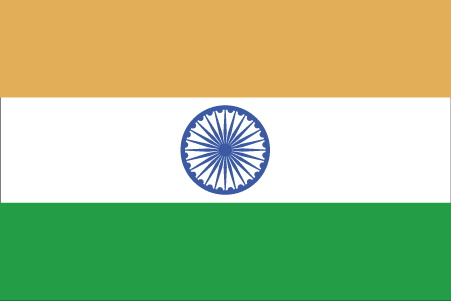
India...
Stats...
Overview:
The Indus Valley civilization, one of the oldest in the world, dates back at least
5,000 years. Aryan tribes from the northwest invaded about 1500 B.C.; their
merger with the earlier Dravidian inhabitants created the classical Indian
culture. Arab incursions starting in the 8th century and Turkish in the 12th
were followed by those of European traders, beginning in the late 15th
century. By the 19th century, Britain had assumed political control of virtually
all Indian lands. Indian armed forces in the British army played a vital role in
both World Wars. Nonviolent resistance to British colonialism led by
Mohandas GANDHI and Jawaharlal NEHRU brought independence in 1947.
The subcontinent was divided into the secular state of India and the smaller
Muslim state of Pakistan. A third war between the two countries in 1971
resulted in East Pakistan becoming the separate nation of Bangladesh. Despite
impressive gains in economic investment and output, India faces pressing
problems such as the ongoing dispute with Pakistan over Kashmir, massive
overpopulation, environmental degradation, extensive poverty, and ethnic and
religious strife.
Population: 1,080,264,388
Location:
Southern Asia, bordering the Arabian Sea and the Bay of Bengal, between
Burma and Pakistan
Map references:
Asia
Area:
Total Area: 3,287,590 sq km
Land Area: 2,973,190 sq km
Comparative Area: slightly more than one-third the size of the US
Capital:
New Delhi
National holiday:
Republic Day, 26 January (1950)
More India Facts...
More Tips on Travelling to India...
Overview:
The Indus Valley civilization, one of the oldest in the world, dates back at least
5,000 years. Aryan tribes from the northwest invaded about 1500 B.C.; their
merger with the earlier Dravidian inhabitants created the classical Indian
culture. Arab incursions starting in the 8th century and Turkish in the 12th
were followed by those of European traders, beginning in the late 15th
century. By the 19th century, Britain had assumed political control of virtually
all Indian lands. Indian armed forces in the British army played a vital role in
both World Wars. Nonviolent resistance to British colonialism led by
Mohandas GANDHI and Jawaharlal NEHRU brought independence in 1947.
The subcontinent was divided into the secular state of India and the smaller
Muslim state of Pakistan. A third war between the two countries in 1971
resulted in East Pakistan becoming the separate nation of Bangladesh. Despite
impressive gains in economic investment and output, India faces pressing
problems such as the ongoing dispute with Pakistan over Kashmir, massive
overpopulation, environmental degradation, extensive poverty, and ethnic and
religious strife.
Population: 1,080,264,388
Location:
Southern Asia, bordering the Arabian Sea and the Bay of Bengal, between
Burma and Pakistan
Map references:
Asia
Area:
Total Area: 3,287,590 sq km
Land Area: 2,973,190 sq km
Comparative Area: slightly more than one-third the size of the US
Capital:
New Delhi
National holiday:
Republic Day, 26 January (1950)
More India Facts...
More Tips on Travelling to India...